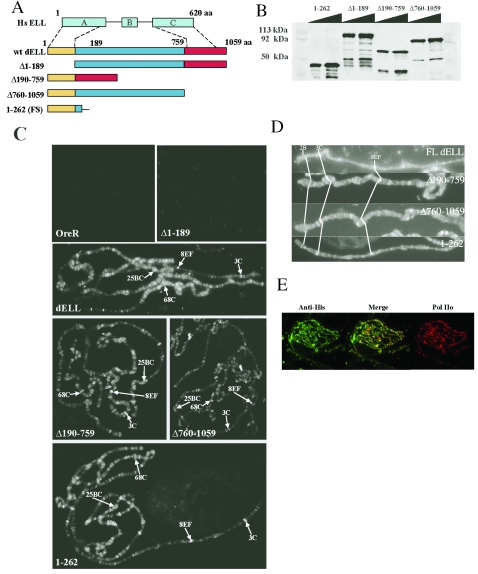FIG. 2.
The N-terminal domain of dELL is necessary and sufficient for localization to chromatin in vivo. (A) Schematic of dELL wild-type and deletion transgenes used in this study. Yellow indicates the conserved N-terminal domain, and red indicates the C-terminal domain. At top is a schematic of the mammalian ELL protein (Hs ELL), with blocks depicting the characterized domains in the protein sequence as follows: A, N-terminal Pol II binding and elongation activation domain; B, lysine-rich region; C, occludin homology domain. (B) Recombinant dELL mutants were expressed in E. coli and analyzed by Western blotting with anti-dELL polyclonal serum to confirm predicted molecular sizes: dELL(1-262), 42 kDa; dELL(Δ1-189), 95 kDa; dELL(Δ190-759), 56 kDa; and dELL(Δ760-1059), 80 kDa. (C) Immunolocalization pattern for dELL mutants on polytene chromosomes. dELL(Δ1-189) fails to localize to chromosomes in vivo (compare to nontransgenic OreR), while dELL(1-262) exhibits a localization similar to full-length dELL and both dELL(Δ760-1059) and dELL(Δ190-759). Landmark sites on the X (3C and 8EF), second(25BC), and third (68C) chromosomes are indicated with arrows to facilitate comparisons. (D) Distribution of dELL deletion mutant proteins is identical to full-length dELL on the X chromosome. Relative positions of the weakly staining landmark puff at 2B, the strongly staining bands at 3C, and 8EF are indicated in X chromosomes from each transgenic line showing chromosome targeting of dELL. (E) dELL(1-262) colocalizes with phosphorylated Pol II on polytene chromosomes. Chromosomes from transgenic flies expressing dELL(1-262) were fixed and stained with anti-six-His and anti-Pol IIo (H5; Covance). Images were merged to visualize extent of colocalization.

